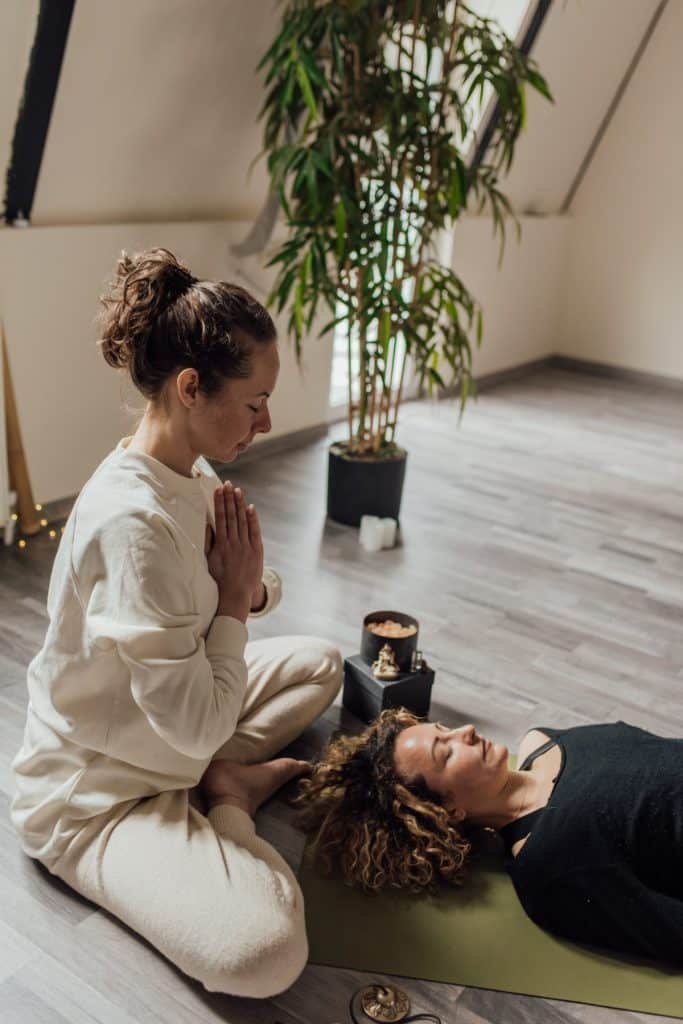The Ayurvedic Doshas
I began studying Ayurveda and the Ayurvedic Doshas as a way of understanding the different ways, each of us function.
I recently had a conversation with my husband, where he told me that he is sure he only needs 5 to 6 hours of sleep each night. I argued that every single person needs at least seven hours of sleep per night.
Upon further study, I discovered that there is of course fluctuation in the sleep demands for each person. Men do actually need less sleep than women do. I still contend that he needs more than five or six hours.
The point is, that we do all have different energies, and we all have different energetic needs. In ancient Indian tradition, this energetics conversation typically involves Ayurveda and the Ayurvedic Doshas.

Table of Contents
What Is Ayurveda?
Ayurveda is perhaps the oldest systematized an organized medicine on earth.
We know that the first humans evolved in Africa and the surrounding regions, and so it makes sense that India would have had some of our earliest civilizations. It seems that an understanding around energy as it relates to the human experience – the mind, the body, and the spirit – was born around the same time that the humans in India were born.
Almost as if those humans brought universal, divine knowledge from spirit into this human experience with them.
They spread the information amongst their communities, and they include it in their spiritual Scriptures – most notably, the Vedas.
At its most basic, Ayurveda is a way of understanding the way that our multiple systems function within us.
It aims to address imbalances, and it seeks to prevent those imbalances through energetic healing that can include meditation, different forms of exercise, nutrition, and working with a counselor or a mentor.
A practitioner of Ayurveda will examine the patient fully, exploring the energy of mind, body, and spirit. They will engage in touching, they will look into your mouth, and ask questions about your lifestyle.
A healthy person, according to Ayurveda, does not simply live, but they live in harmony with others, and with nature. The expectation is that people can live a long and healthy life free of illness and negativity.
One of the things that is important to understand about Ayurveda is the concept of Dosha.

What Is a Dosha?
Interestingly, enough, and perhaps not surprisingly, science seems to be catching up to Ayurveda. Recent studies have shown models of Dosha brain types that help us understand the way each of us functions and ideally thrives with all of our systems.
According to Ayurveda, there are three Dosha types – Vata, Pitta, and Kappa.
The theory is that each one of us functions from primarily one of these energetic directions.
And science seems to agree.
A growing body of research shows patterns of blood chemistry, genetic expression, physiological states, and chronic diseases associated with each Dosha type.
This news is remarkable, because if you can figure out your Dosha type, then you can practice Ayurveda to keep your Dosha in balance, and avoid negative health outcomes.
Each Dosha type is associated with patterns of functioning of six major areas of the nervous system: the prefrontal cortex, the reticular activating system, the autonomic nervous system, the enteric nervous system, the limbic system, and the hypothalamus.
When we can combine eastern medicine and modern science, we potentially hold the key to unlocking genuine longevity.
And it all may come down to the Ayurvedic Dosha.

What Are the 3 Ayurvedic Doshas?
All three Ayurvedic Doshas – Vata, Pitta, and Kappa – are found to one extent or another in each human, but each of us is ruled by a primary Dosha, or energy center.
The same goes for each day, there are different Dosha times of the day, which tell us where we should be focusing our energy at that time, regardless of our individual Dosha.
Vata

The Vata Dosha is high energy, think flexibility, creativity, and action. It is most closely associated with the wind element, and we typically see this energy in our free flowing spirits.
Someone with a strong vita, Dosha is often very thin, usually cold, has dry skin, and has racing thoughts.
Remember, you don’t have to have a Vata Dosha as your primary, to have your specific Vata Dosha out of balance.
An imbalance reveals itself typically in the form of anxiety, fear, and digestive issues like constipation. If you find yourself, vibrating, agitated, and experiencing racing thoughts, you need grounding.
To bring balance to your Vata Dosha, think about creating more structure in your life – establish strong morning and night time routines, practice earthing – putting your bare feet on the actual ground, make sure you include more protein and more fat, as well as warm foods and root vegetables in your diet. Also make sure you’re drinking plenty of water and healthy, herbal teas.
Vata Dosha rules the times of day from 2 PM to 6 PM and from 2 AM to 6 AM.
What what this means for everyone looking to create energetics balance during the day, is that from 2 PM to 6 PM your focus should be on allowing creativity and expansive thinking to peek.
This is a great time to pursue your creativity and problem-solving skills.
The thinking goes that if you channel the correct energy at the correct time of day, you are much more likely to keep your doshas in balance.
Pitta

People who have Pitta Dosha as their primary energy center are often of medium build, feel cold often, and have skin issues like acne or eczema. We find them to be very busy (classic hustle culture), high achieving, and always moving.
Pitta is most commonly linked to the fire element, and is that control, the endocrine, metabolic, and digestive systems.
If you have a Pitta Dosha out of balance, you’ll find yourself angry, overexerted, overwhelmed, burnt out, and probably also with skin irritation and rashes.
To bring balance to your a Pitta Dosha, focus on activities that keep you cool – think cold plunges, cold showers, drinking cold drinks, eating cool vegetables and fruits.
Avoid hot, spicy, and fermented foods, stay out of saunas, and seek shade and shelter in warmer temperatures.
Pitta Dosha rules the day from 10 AM to 2 PM and 10 PM to 2 AM.
This time period is the peak of productivity. If we allow this energy to flow through us, we harness the midday heat, and we are propelled to be productive and accomplish our goals. If you have some thing that you must get done, this is the time to do it.
This does not, of course, mean that you should be engaging in vigorous exercise. On the contrary, Ayurveda suggests vigorous activity take place much earlier in the day or much later in the afternoon, during Kapha Dosha.
Kapha

The Kapha Dosha is stabilizing energy. It is the energy that supplies water to the body and maintains a healthy immune system.
Someone whose primary Dosha is Kapha, is calm, grounded, and forgiving.
This Dosha is most closely associated with the elements of both water and earth.
An imbalance here shows up as jealousy, sluggishness, and excessive weight gain.
To stay in balance, it is wise to incorporate strong, even radical, self-care. Engage in activities that stimulate the mind, make exercise a priority, and integrate meditation and breathwork into daily life.
If out of balance, avoid heavy, dense foods. I am instead or fresh and bitter foods like fruits and veggies.
This final Dosha, Kapha, begins at 6 AM and ends at 10 AM, and then begins again at 6 PM and ends at 10 PM.
Because this Dosha is associated primarily with sluggishness, went out of balance, it is suggested in Ayurveda that you rise before 6 AM, less you find yourself waking up feeling sluggish.
Ayurveda tells us that waking up by 530 allows us to fully embrace the day, along with the other Doshas, which counsel us to build a strong routine, and channel are creative energy, at the appropriate times.
This time from 6 to 10 is the time for meditation, a light breakfast, and preparing to face the day.
What Is Your Ayurvedic Dosha?
Now, how do you know what your Ayurvedic Dosha is?
You probably already have a sense from the descriptions above, and there are a million quizzes you can take online to find out exactly what you’re Dosha is.
Be mindful when you’re taking an online quiz, but you should probably take several, and then allow the common denominator to decide for you.
But in general, it helps to know that those with a dominant Vata Dosha learn, quickly, are highly creative, are multitaskers, are kind hearted, are flexible, and are naturally slender.
Those with a dominant Pitta Dosha tend to be intelligent, purposeful, learn quickly, our self determined, master skills, easily, are driven by success, and are natural leaders, they tend to have good circulation, healthy skin, and high metabolism.
Finally, a dominant, Kapha Dosha is seen in people who are empathetic, caring, trusting, patient, calm, wise, happy, romantic, and have strong bones, joints, and a healthy immune system.
Of course, there is so much still to learn about Ayurveda and the Doshas, but this will get you started.
Happy manifesting!






